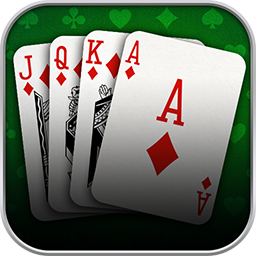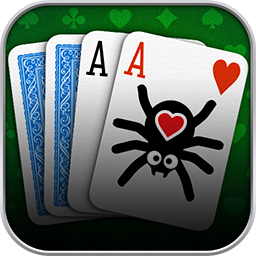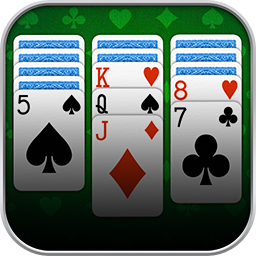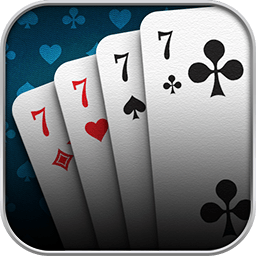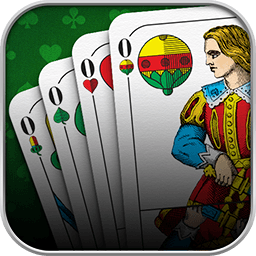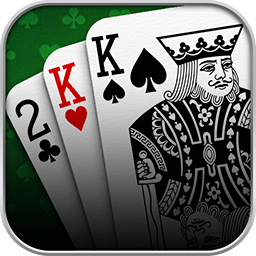At the Solitaire Palace, you get to play Klondike Solitaire online in real-time against fellow card game enthusiasts from all over the world! We offer classic Solitaire rules perfectly adjusted for novices to make getting started easy. Once you gained some experience, you can employ custom rules to create the game you enjoy most. Go easy or go for a challenge!
In short, Klondike Solitaire is a type of patience game. You aim to sort a deck of cards by using attention, strategy, and memory: Seven piles of cards are in the middle of the table, the tableau, with each top card revealed. You can reveal one card at a time from the stock when you need a little help. Sort the sequences from King to Ace by moving revealed cards from one tableau pile to the other, revealing the new top card of the first pile. In the end, there should be four correctly sorted suits in the foundation.
We also added a multiplayer option. Find out all about it below! This thorough manual will guide you through all the Solitaire game rules and terms in detail. To quickly look up single terms, take a look at our glossary! And use our in-game help to answer any questions coming up on the fly during playing at the Solitaire Palace.
In the Solitaire Lessons, we are taking a closer look at individual game aspects. Maybe there is something new in it for you, too!
Cards and Solitaire Playing Field
Klondike Solitaire uses one standard deck of traditionally French-suited playing cards: The suits are Spades, Clubs, Hearts, and Diamonds. All 13 ranks – King, Queen, Jack, 10, 9, 8, 7, 6, 5, 4, 3, 2, Ace – occur once in each suit, resulting in 52 cards in total.
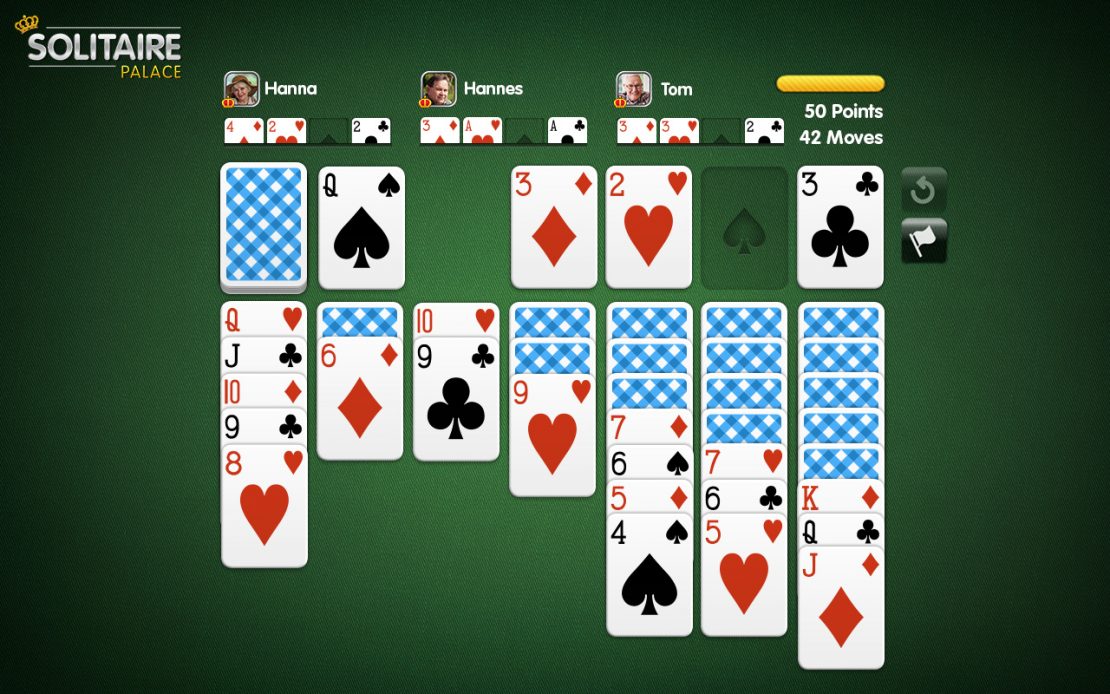
The playing field at the Palace is made up of three main areas – the stock and waste on the top left, the four foundation piles on the top right, and the seven tableau piles in the center of the table.
Above the playing field, you see how much time you have left to solve this round, how many points you gained so far, and how many moves you made. In multiplayer mode, your opponents’ progress is displayed there as well.
The Aim in Solitaire
In a round of Klondike Solitaire, you want all cards to end up in four piles in the foundation, each in one suit only. To achieve this, you must first reveal all cards: You can sort the cards into sequences in the tableau. And you need to reveal the stock over time, to add its cards to the tableau or the foundation. Only individual cards can be moved to the foundation, starting each pile with an Ace. The pile continues up 2, 3, 4, 5, 6, 7, 8, 9, 10, Jack, Queen, leaving the King on top.

In multiplayer mode, the aim is to finish quicker and more effectively than your fellow players: A round ends shortly after one player places all cards in the foundation, when no player can make any more moves, or when the time is up. At the Solitaire Palace, you can play several rounds at a table, continuously collecting points. A table ends, when a preselected number of rounds is finished. The player with the highest total score wins!
Sometimes, a round simply cannot be solved. Then, you can give up the game at any time. The points gained until giving up will make up your score for that round.
Stock & Waste
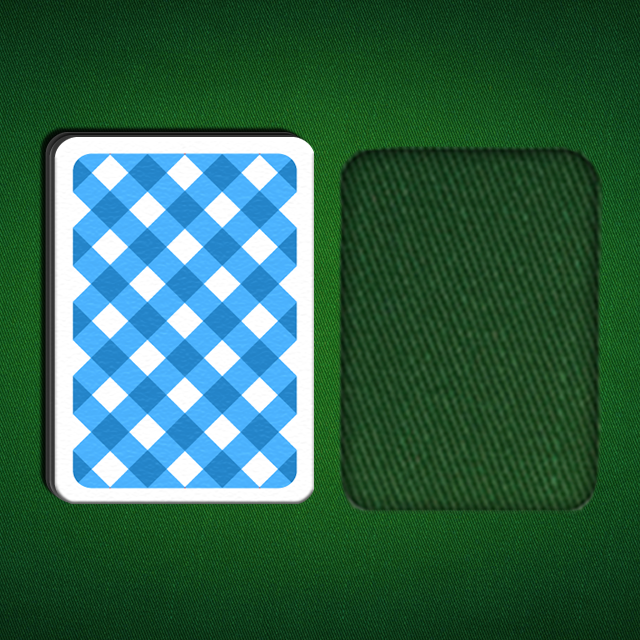
After filling the tableau at the beginning of a round, 24 cards remain face-down as the stock in the top left of the playing field.
During play, you can reveal one stock card at a time by moving it to the waste, which is empty initially.
You can reveal a card from the stock as many times as you want. But you can only add the top card of the waste to the tableau or the foundation. After emptying the whole stock pile, any remaining waste cards become the face-down stock again after you click once more.
Foundation
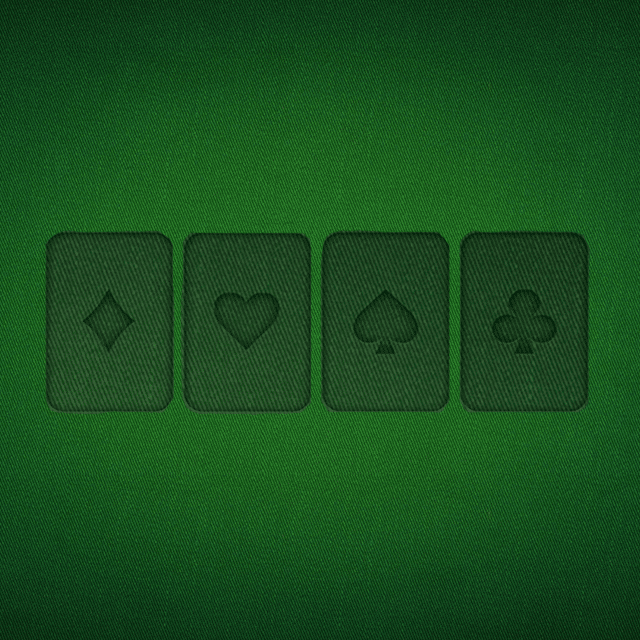
The four panels on the top right of the playing field are empty at the beginning of the round. They are the foundation piles, where you want all sorted cards to end up. The following rules apply:
- Each pile can only contain one suit.
- The ranks of each pile must be placed there in ascending order: The first card placed there is Ace. The pile continues up 2, 3, 4 … until the sequence ends with Jack, Queen, and King.
Tableau

At the beginning of a round, 28 cards are arranged in the tableau. The first of seven piles in the middle of the table contains one card. The other six piles each contain one more card than the previous pile. Each top card is revealed.
Here, you can move cards from pile to pile. After removing all the revealed cards from a pile, the new top card is revealed. Now, it is accessible since only revealed cards can move to the foundation. In order to move several cards in the tableau, you must sort them, and you can also add cards from the waste to the tableau. There are specific rules for sorting the cards in the tableau:
- You must sort the cards uninterrupted in descending order, starting with the King at the bottom, continuing Queen, Jack, 10, 9, 8, 7, 6, 5, 4, 3, 2, and Ace on top.
- Alternating red and black suits: A card of a red suit, Hearts or Diamonds, must follow a black suit, Spades or Clubs, and vice versa.
- You can start sorting with any card.
- You can only place a King on an empty tableau pile.
- More than one card can be moved from one tableau pile to the other if the moving cards are sorted by the previous rules and match the target card following these rules.
Cards can be moved from the tableau to the foundation individually. If Aces are revealed at the very beginning, you can move them to the foundation right away!
Undo & Give Up
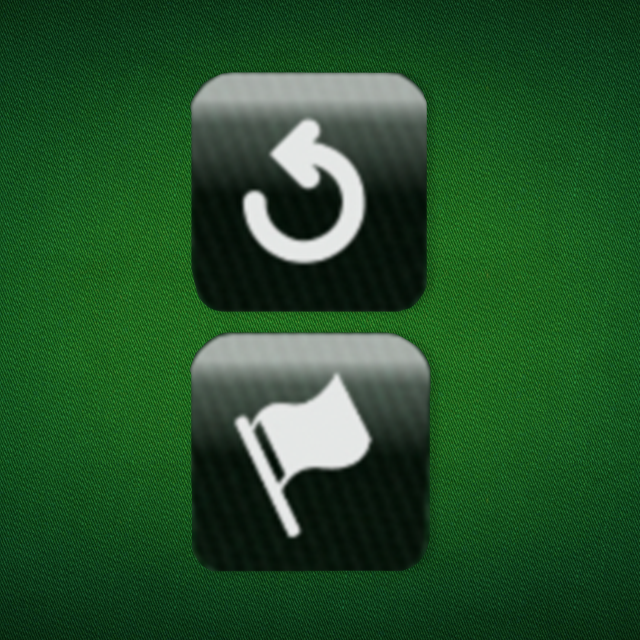
If you run out of options in the tableau, you can undo one or more actions. Undoing can come in handy when you placed a card onto the wrong tableau pile or change your plan in hindsight. To make the Solitaire card game more challenging, you can also deactivate this option using our custom rule Undo Off.
From time to time, a game cannot be solved at all or not anymore with your approach. In such moments, you can give up the game without leaving the table in multiplayer mode by clicking the white flag.
Solitaire Scores
Solving the game is one thing. But let us look at how to win Solitaire, now. Every move you make counts – literally! In Klondike Solitaire you gain or lose certain numbers of points for specific actions. Certain custom rules and playing in multiplayer mode affect these scores. See the chart below the image for detailed info.
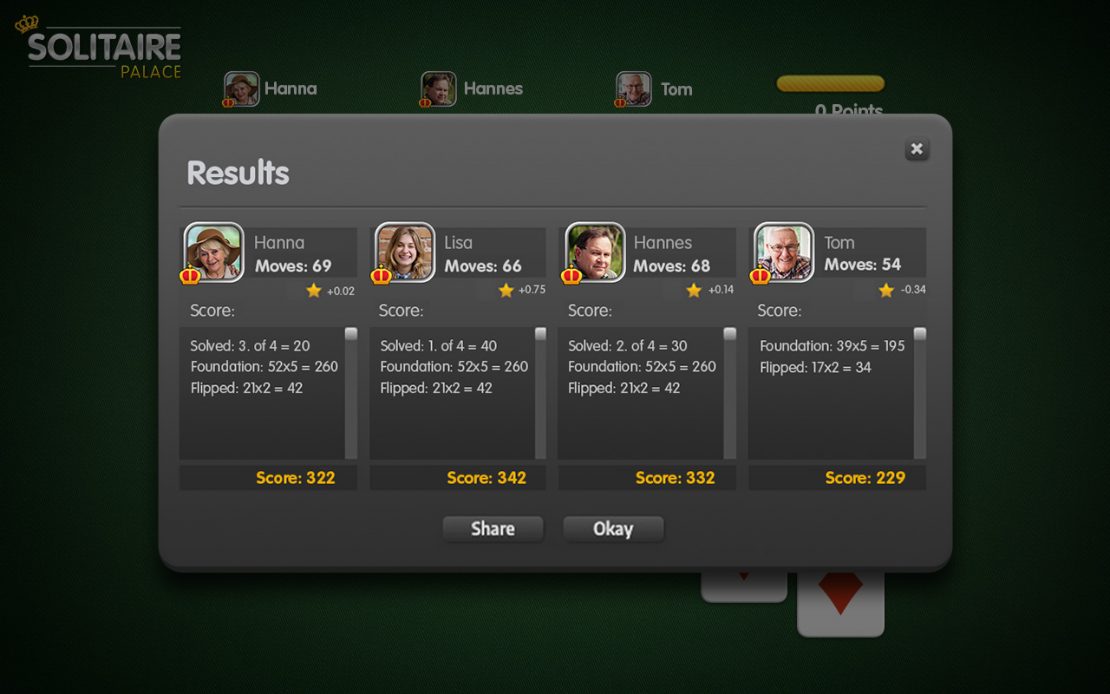
| Action | Points Solitaire | Points Easthaven |
|---|---|---|
| Placing a card in the foundation | +5 | +10 |
| Revealing a card in the tableau | +2 | +4 |
| Browsing the stock anew | -2 | not applicable |
| Undoing a move | -1 | -1 |
| Solving a round | +1 | +1 |
| Bonus points when solving a round in multiplayer mode: For each fellow player unable to solve the round or needing more moves than you to do so | +1 | +1 |
| When using the custom rule Joker: | ||
| For each unused Joker | +3 | +3 |
A round ends either shortly after one player placed all their cards onto the foundation piles, when no player can make any more moves, or when the time is up. Each player receives their gained points up to this moment as their round score.
At a table at the Solitaire Palace, you can play several rounds, collecting points continuously. A table ends when a preselected number of rounds is finished. Finally, the player with the highest total score wins!
Spice it up With Custom Rules
We do not only offer the standard Solitaire rules but plenty of custom rules for individual and exciting Solitaire creations. You can choose from the following options to modify the basic Solitaire rules:
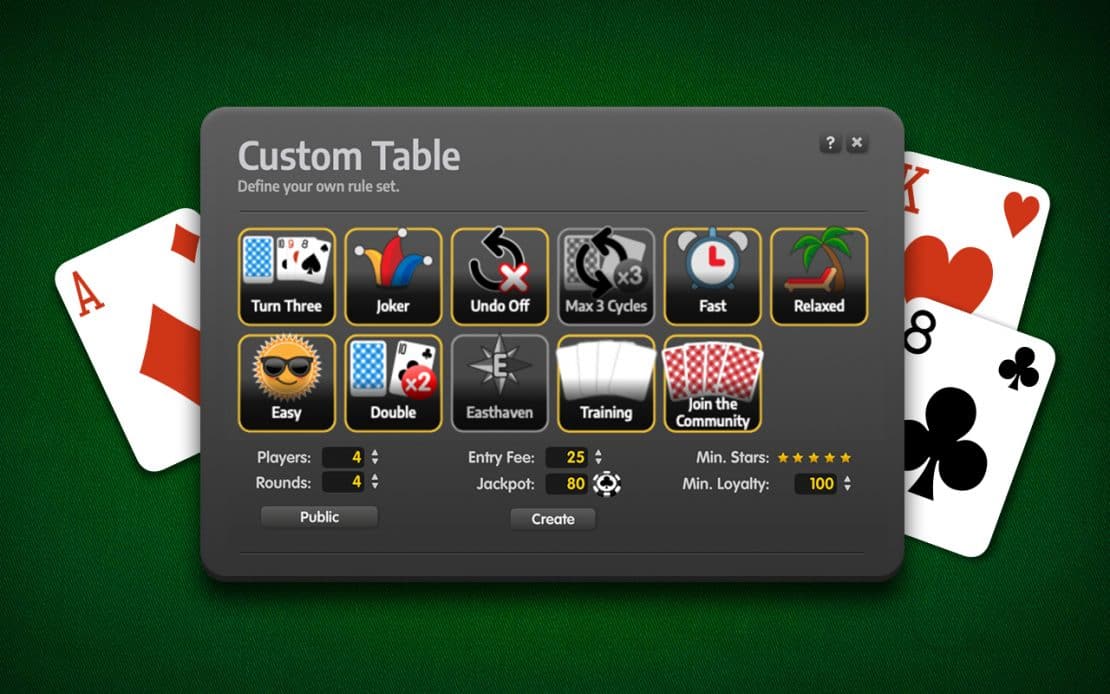
| Custom Rule | Description |
|---|---|
| Turn Three | Three cards instead of one card will be moved from the stock to the waste in one go. Since you can only use the top card of the waste, this makes the game more challenging. |
| Joker | With this custom rule, each player receives three Jokers: An additional button showing the Joker symbol appears on the playing field. When using a Joker, you select a foundation pile which will automatically receive a matching card. This card will go there from its position in the tableau, stock or waste. When solving a round, unused Jokers add bonus points to your total score. |
| Undo Off | Disable the undo feature with this custom rule. You now have to see your decisions through to the end of the round. This makes the game a bit more challenging. |
| Max 3 Cycles | You can flip through the whole stock three times at most. Consequently, you must play more strategically. |
| Fast | This custom rule shortens the standard play time. All players have less time to solve the game. |
| Relaxed | When playing Relaxed, all cards of the tableau pile are revealed from the beginning. This way, the game is easier and more tranquil: You can see where crucial cards are and thus free them strategically. |
| Easy | Using this custom tule, you can play any card onto empty tableau piles. In standard Klondike Solitaire, only Kings are allowed there. |
| Double | Play with 104 instead of 52 cards with this custom rule. This popular variation is called Double Solitaire. |
| Easthaven | This custom rule switches the game to Easthaven, a relative of Klondike Solitaire. The modifications are few but significant. That is why we explain their differences in the chart below. |
| Training | With this custom rule, the results of the table do not affect your standing in the league. You still collect experience points, though. |
Easthaven
We summarized the differences between our standard Klondike Solitaire and Easthaven here. For a thorough explanation using examples, we invite you to check out our third Solitaire Lesson.
| Klondike Solitaire | Easthaven | |
|---|---|---|
| Setup |
|
|
| Using the stock | You reveal one card at a time on the waste. You choose if you add the top card of the waste to the tableau or not. | There is no waste. Instead, one stock card is dealt to each tableau pile automatically in one go. |
With so much room for variation and new challenges within one game, you decide: Do you want to play easy or do you want to face a real headscratcher? You are welcome to try it!
Do you want more card games?
We bring you numerous popular card games alongside Klondike Solitaire at the Palace of Cards. There are more solitaire variations at the Spider Palace: Spider and Scorpion! We also have trick-taking games such as Pinochle, Skat, Sheepshead, and Doppelkopf. And you can find classics such as Rummy and Canasta along with Mau-Mau.

